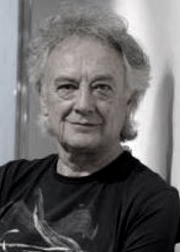A. Costa
The Galician makes posters and participates in international collectives. He makes series of engravings that increase his prestige and ¡s part of exhibitions that tour Havana and Lisbon. He ¡s already prepared for major undertakings. In 1984 he completed one of his great endeavors, a painting of 2,000 square meters, begun three years earlier, at the Frenopathic Institute of Barcelona. He illustrates series of articles in the press, Signed by his friend the writer Xavier Costa Clavel, and the poems of Rodríguez Aguilera. His exhibitions take place throughout Spain. In 1983 he obtained a scholarship from the Ministry of Culture, and the City Council of Noia awarded him the medal of the town, to which he has dedicated festive posters and other celebrations. His presence in the book’s constant, with illustrations for works by Costa Clavel and Neira Vilas. New murals, in 1985, in a Coruña industry and at the Xelmírez de Compostela Institute. More murals, in prison establishments. Important exhibitions outside of Spain. We are in the eighties, of intense activity for the artist, who has consolidated his fame abroad, mainly in France and Germany. In 1988 he held a large exhibition at the Kiosko Alfonso de A Coruña, which demonstrated to his countrymen the justification for his fame. He receives official
commissions constantly. The folders of his engravings are of interestto collectors. His fame is consolidated inside and outside of Spain. He appears in the Provincial museums of Lugo, Pontevedra, Sada, A Coruña; of Modern Art of Barcelona, of Palma de Mallorca, of Hospitalet, Barcelona, Provincial of Burgos, of Modern Artof Madrid, Zabaleta de Quesada, Jaén; from Gerona; from Ostend, Belgium of Vigo and the March foundation, in Madrid. He ¡s also represented in official institutions such as the
Padre Sarmiento Institute of Santiago, the University of Compostela, the Xunta de Galicia, the A Coruña City Council, the Generalftat of Barcelona, fhe Provincial Councils of Santander, Gerona, Guadalajara, and the Congress of Deputies. Costa Beiro’s paínting is a highly personal Iyrical expressionism.
He has concomitances with Francis Bacon, albeit from total liberties. His figures dance and have an irepressible dynamics. They are registered in funds such as mirrors of lost quicksilver, in pinks, carmine, blues, and yellows. Based on a prodigious, rhythmic drawing, the material is light, elegant, with very rich textures and tonal contrasts of stained glass effect He has practically never departed from a vague figuration, although the doses of abstraction are considerable. He knows how to take advantage of the resources of cubism and even surrealism in measured compositions, in which well-
digested geometry beats. An enormous joy, a playful environment presides over these paíntings in which are the myth, the dream, the evocation and the ideation in infinite perspectives that are related, sometimes, with the less rigorous Dalí, whom he undoubtedly knows well. In his own way, Costa Beiro as a good Galician, is a passionate baroque and, in short, a great creator and an enormous painter.

